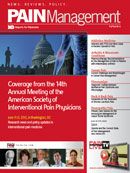Publication
Article
Pain Management
ASIPP Position on Single-dose Vials Receives Support from Bipartisan Group of Lawmakers
Several Senators and Representatives call the current regulations wasteful and poorly conceived, and say they will work to make needed changes.
Several Senators and Representatives call the current regulations wasteful and poorly conceived, and say they will work to make needed changes.
The 2012 annual meeting of the American Society of Interventional Pain Physicians (ASIPP) featured a lengthy and informative Q&A session Tuesday morning with several US Senators and Representatives, with the majority of the discussion focused on three key issues identified by ASIPP leadership as being of vital importance to the practice of interventional pain medicine:
- Secure ongoing funding for the National All Schedules Prescription Electronic Reporting Reauthorization Act (NASPER), which is a program administered by the US Department of Health and Human Services that grants money to states to fund prescription drug monitoring programs.
- Eliminate the current Centers for Disease Control and Prevention (CDC) and Centers for Medicare and Medicaid (CMS) guidelines requiring that physicians use one single-dose vial of injectable medications per patient.
- Eliminate the Patient-Centered Outcomes Research Institute (PCORI) established under the Accountable Care Act to promote comparative effectiveness research.
Of these three hot-button topics, the single-dose vial issue received by far the most attention from ASIPP members and legislators alike. In a nutshell, the CDC and CMS, in the interest of promoting safe infection control practices and procedures, require that vials of injectable drugs labeled by the manufacturer as “single dose” or “single use” should be used by clinicians for only one patient, with the rest of the unused medication to be disposed of properly. The CDC claims that, because these medications typically lack antimicrobial preservative, they are vulnerable to potential contamination “and serve as a source of infection when they are used inappropriately.”
ASIPP contends that these guidelines “are not based on evidence or sound reasoning, but rather are based on limited case-reports, inaccurate and incomplete information, and conjecture” and that they are “overreaching, expensive, and burdensome to the practice of medicine and may ultimately result in reduced access” to needed care, especially closed procedures including interventional techniques. ASIPP chairman and CEO Laxmaiah Manchikanti, MD, noted during a session earlier at the conference that a study involving more than 3,000 patients and more than 18,000 procedures performed in an ambulatory surgery center that used standard precautions for clean procedures and safe injection practices found no evidence of infections of any significance associated with the use of single dose vials for multiple patients.
It is ASIPP’s position that, not only are these guidelines not grounded in evidence or sound reasoning, but that compliance with them is extremely expensive and “may lead to an inability to perform these procedures and may put many practices out of business, ultimately eliminating access to services.” This is because, according to ASIPP, the cost of single-dose vials is “enormous, with the procedural cost of contrast medium [for example] jumping from $6 to $60 in the face of increasing regulations and decreasing reimbursement.” If practices are required to adhere to the single-dose vial rules, this will result in significantly increased costs for each procedure and significant wastage of injectable drugs, many of which are already experiencing shortages. ASIPP claims that because the current reimbursement levels for the procedures that utilize these drugs are less than the projected increase in costs due to compliance with the single-dose vial rule, “it is clear that the end result could feasibly be the complete elimination of these procedures” by practices that cannot afford to offer them.
During the Q&A session, several legislators voiced support for the ASIPP position regarding the single-dose vial issue. Rep. Edward Whitfield (R-KY) said that this “illustrates how health care is becoming micromanaged by bureaucrats.” Sen. John Boozman (R-AR), an optometrist by training, said that he has worked hard to get the regulatory agencies to understand the single-dose vial issue, which the senator said is an illustration of “the lack of common sense in the regulatory process, which ultimately drives up costs for business.”
Rep. Andy Harris, MD, (R-MD) also supported modifying the single-dose vial rules, noting that he and several other House colleagues had signed a letter to HHS Secretary Kathleen Sebelius stating that the current one vial per patient rules do not reduce health care-acquired infections, but instead “increase costs for providers and taxpayers without improving quality.” He also said that physicians should be insulted that they’re basically being told by CDC and CMS that those organizations do not believe that physicians are capable of following safe injection practices and acting in the interests of patient safety. Sen. David Vitter (R-LA) concurred, saying that the current single-dose vial regulations “are an example of a bureaucratic mandate that defies common sense and wastes enormous amounts of needed medications.”
